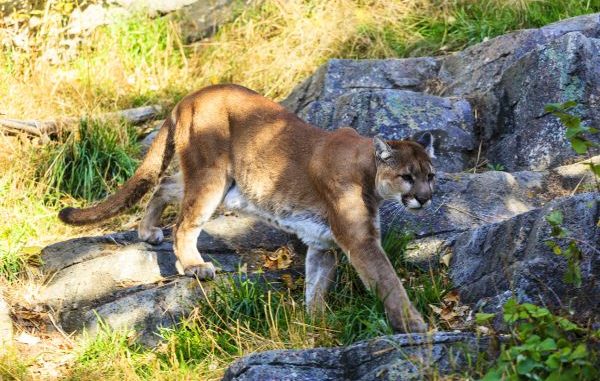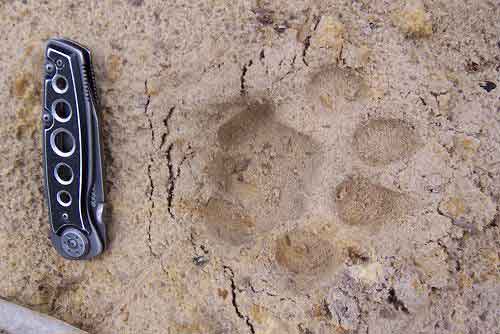
The debate rages on…
I always enjoy a good, spirited discussion about an interesting topic, and how much more interesting and controversial could a discussion be than one centered around the existence of large cats — panthers, mountain lions or maybe you prefer to call them cougars — in Mississippi and its neighboring states?
As I lay in bed early this morning about half awake before my bedside alarm sounded, I began to reflect back on several first-person encounters I have had over my lifetime with large cats.
After rising and retrieving my morning newspaper, I grabbed a steaming mug of coffee and began to dig into the thick Sunday edition for the sports section.
On Sunday mornings this is a two-pronged endeavor, as the weekly Outdoors page is added to my everyday quest for knowledge regarding all things SEC.
To my absolute surprise, the half-page main Outdoors section article was titled “Panther tracks in Miss?”
This had to be a sign that I needed to stir the panther pot a little, as it was way too coincidental an occurrence.
Let’s look at a blend of anecdotal evidence in contrast to what wildlife officials say.
Now, regarding my qualifications when it comes to knowledge about identification of large cats at close range, I have had my full share of encounters over the years. My experience falls into two main categories: experience in Mississippi and experience while living for a time in Montana.
My Montana experience includes personally having cougars at the eight- to 10-step range on at least two occasions.
One time, as I walked quietly along a woods road in the early morning gloom, a cougar stepped out of the roadside brush into the trail right in front of me. The cat crouched, with ears pinned back, and let out a long, low growl before clearing the road in one leap and disappearing into the wood line, growling the whole way.
On another occasion, while predator calling, I called up a huge cat that crept through tall grass to a distance of about eight steps from my position, before its head and shoulders suddenly materialized in a crouch, looking intently for the source of the distressed fawn call that I had been making.
No, I held my fire and did not shoot the cat because it was not cougar season, but I stayed stock still while looking down my rifle barrel with finger poised over the trigger. It was close enough that I could clearly see droplets of moisture in the big cat’s whiskers through my Leupold scope.

The cougar eventually eased backward into the tall grass and disappeared as stealthily as it had arrived.
So I know a cougar when I see one.
I have also tracked and been tracked by cougars with snow on the ground, so I also know what their tracks look like.
With that out of the way, let’s circle back to the purported existence of panthers in this area of the Southeastern United States.
For decades now, there has been a steady drum beat of sightings and reports scattered across the Gulf States that range all the way from being highly credible to being verifiable misidentifications and rank fabrication.
A true cougar specimen in the wild would be hard to mistake for a domestic cat or a bobcat, providing it is clearly seen and has surrounding objects of known or verifiable size for scale.
Panthers are a federally protected endangered species. They are generally described as being tan in color with a long, black-tipped tail, with adults weighing between 70 and 120 pounds.
A full-grown cat would measure around 7 feet from nose to tip of tail and stand about 2 feet tall at the shoulders.
The scientific name for the “Florida panther” variation of cougar that once called Mississippi and Louisiana home is Puma concolor couguar.
The question is, though, does a remnant breeding population still exist in scattered locals outside of southern Florida?
If enough of the sightings can ever be undeniably verified as being from actual wild cougars, the resulting revelation would point to the existence of a breeding population.
One of the most-comical explanations from certain officials — at least for me — involves them throwing out the “it’s an escaped pet” line. It is certainly possible that a few scattered folks have pet cougars, but with all of the seemingly credible cougar sightings that we persistently hear about, that would indicate they would have all escaped, and then some to boot.
I have looked, as I am sure many of you have, at numerous YouTube videos that purportedly show encounters with “panthers,” some of which seem very credible. There are also occasional trail cam photos that show up on websites and message boards of what appear to be cougars as they cross deer food plots and woods roads.
One of the biggest debatable aspects of this whole controversy revolves around the term “black panther.” Wildlife officials flatly deny the existence of any sort of native melanistic big cats, in spite of the fact that a surprising proportion of all big cat sightings reported in states east of the Mississippi River are of black cats with estimated weights that exceed 65 pounds.
This particular mystery has baffled research professionals and officials for decades.
Let’s now look at my personal list of encounters of the cougar kind during my decades spent living, hunting and traveling around Mississippi.
My first encounter was an indirect one as a young grade-schooler tagging along with my dad, uncle and others on an overnight fishing trip on a sandbar of the Pearl River close to where the old Highway 43 bridge. The year was about 1956 or ’57, and we had a bonfire and trot lines out.
I distinctly remember hearing a panther “scream” from the woods across the river in the middle of the night.
My second encounter occurred back in the mid- to late 1970s when I was invited to accompany a friend on a deer hunt in Southwest Mississippi. I took my younger brother with me, and the three of us hiked in and took up positions about 200 yards apart along the deep-cut, sandy-bottomed Coles Creek, which bisected the hunting property.
I was in the middle position and hadn’t been settled in too long with I heard the loud report of my brother’s 12-gauge slug gun.
Thinking that deer must be moving and that he had just bagged one, I kept a close vigil on the creek crossing I overlooked. It wasn’t long before I heard a loud crack-boom in the direction of my friend, who was also situated on a high bank of the creek watching several deer crossings.
When we regrouped later, I found out that a cougar had come slinking along our back trail and, when it got to the edge of the shallow, sandy creek, it came bounding across straight toward my brother.
Fearing it was an attack, he grabbed his slug gun and half-aiming sent a slug toward the cat that was now only yards away. The cat reversed course in mid-air and vanished in a flash.
About a quarter hour or so later, our friend said he saw the cat cautiously emerge from the brush along the steep bank at a deer crossing that was, as I recall, about 50 or 60 yards away from him. The cat was a tawny tan colored, and was roughly the size of a deer and had a long, swishing tail. My buddy was looking at it through a rifle scope, so he had a clear view.
The cat, having already been shot at and spooked, stopped in mid-stream in a crouch peering intently into the opposing brushy creek bank. My friend took careful aim and fired.
Thankfully, they both missed, and these are boys who didn’t often misfire.
My latest personal eyeball encounter occurred in northwest Hinds County in the hills about 2 ½ miles from the Big Black River about 10 years ago. I was sitting in a box blind late one afternoon in a big field surrounded by woods, armed only with a digital camera.
Movement at the nearby tree line caught my attention and, as I eased around for a better view, I saw what appeared to be a rabbit dart out and then back into the cover with a tan-colored cat-like animal weighing probably about 60 or 70 pounds with a long tail in pursuit.
They serpentined in and out of the cover once or twice more, and then everything went quiet.
I sat in shocked disbelief, realizing that I had just watched a panther.
After a short while, the cat walked back out into direct view in a freshly mowed area about 60 yards away and sat down on his haunches.
Suddenly, realizing that I had a digital camera sitting next to me, I dropped my Swarovski binoculars and grabbed the camera, which was not turned on. As I yanked off the lens cover and fiddled with the on-off button, the cat got up and started slowly walking toward the wood line.
I pressed the button too hard and the camera came on and the lens extended and then just as quickly turned off and the lens retracted.
My moment for fame was over as the cat vanished from sight.
Relating this story to nearby neighbors elicited several stories of encounters they had also had but had been reluctant to tell anyone about.
I don’t know about you, but I am a believer.
As the old adage goes, where there is enough smoke, there has to be a fire somewhere.


